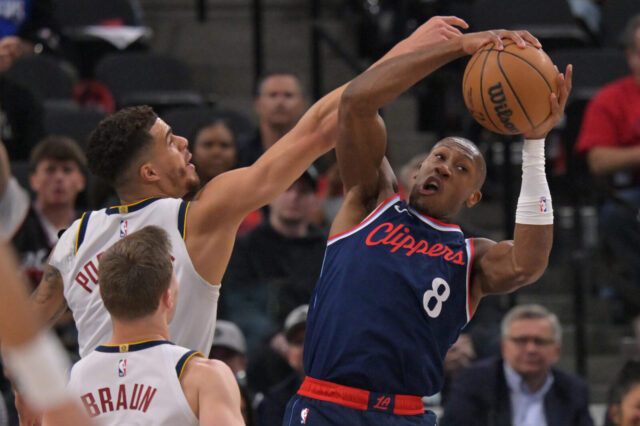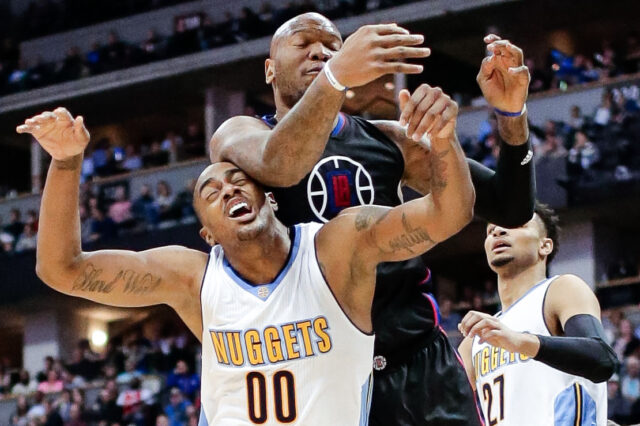Emmanuel Mudiay arrived in the NBA just over a year ago, and walked across the stage after being announced as the Nuggets selection in the 2015 draft with a label affixed to his game.
"D'Angelo Russell is a better prospect than Emmanuel Mudiay, and it's not really close," read a headline on an article written in June. "There's a ton of talent here, but his ceiling depends on him developing his jumper — a lot," was the conclusion reached in a Philly Mag article.
"For long, painful stretches of many NBA games, Mudiay is the worst point guard in the league," wrote a Denver Post columnist two weeks before Christmas. "That is not a hot take, or even a complaint. It's merely the truth."
“Mudiay’s shooting ability was a question coming in to the NBA, and he’s not only been erratic, but downright terrible,” was the consensus on December 18.
"Shooting was a noted weakness of Emmanuel Mudiay before he entered the league, but it's fair to say the Nuggets didn't think he'd be quite this poor when they drafted him No. 6 overall this summer," a blogger wrote on January 7 for the NBA Hangtime blog.
The assault didn't stop after the All-Star break, with comments like, "Clearly, the Nuggets' rookie has to improve his shooting if he's going to be an effective NBA player and avoid becoming a bust" continuing to be penned.
"The most looming issue with Mudiay's offensive game lies with his poor shooting form, which is raw and inconsistent," wrote one Evan Fiala in March.
But Mr. Fiala continued on to write the following:
We're nearing the end of his first NBA season, and Emmanuel Mudiay still has a seemingly unlimited upside.
Shooting form, mechanics, and developing a long-range shot are all things that will be taken care of in the offseason. Turnovers will also decrease the more he plays and the more familiar he gets with running an offense. He's already shown he can be a leader, as not many teenagers can be handed the keys to an NBA team with the poise and attitude that Mudiay has.
"Shooting form, mechanics, and developing a long-range shot are all things that can be taken care of in the offseason." Wise words from a wise man (whom you should follow on Twitter).
The comments on Mudiay's shooting early in the season aren't wrong – they are made based off of facts, and were accurate when they were written. But the label of "inefficient shooter" was stuck on Mudiay after one month of games – one month of data for a player that had 12 games in China as the highest level of play achieved prior to making the NBA.
Early in the season, Mudiay's form was off. He'd shoot on the way down, it looked like he was double-clutching on nearly every jumper, his legs were akimbo, and his shoulders weren't lined up. Watch the clip above and you can see why it would be hard to make jump shots consistently.
But Mudiay is a hard worker, and a smart worker to boot. He worked with Mike Miller, practicing better mechanics to become a more consistent shooter. It's hard for NBA players to transform their game during the season, but after hovering around 30 percent shooting into January, Mudiay began to find success, and raised his field goal percentage up to 36 percent by the end of the season.
Here's a chart showing Mudiay's field goal percentage over the course of the season. The numbers show that things began to improve after he returned from his ankle injury for a homestand in January. The Nuggets played eight straight home games, and Mudiay reestablished himself as the starter in the third game, a 129-126 win over Indiana.
This content is no longer available.
Mudiay was shooting 24 percent on 3-point shots when he suffered his ankle injury in December. When he came back, he had a long way to go to be a respectable 3-point shooter, but he improved his percentages by nearly 30 percent over the remainder of the season. It's undeniable that Mudiay had a bad start to the season, but it is equally undeniable to say that Mudiay was about the same 3-point threat in the second half of the season as players with more sterling reputations from the perimeter like George Hill, Patty Mills and Chris Paul.
| Player | Games (post-All-Star) | 3PM | 3PA | 3P% |
| Patty Mills | 28 | 1.6 | 4.4 | 37.1 |
| Emmanuel Mudiay | 28 | 1.5 | 4.2 | 36.4 |
| George Hill | 28 | 1.5 | 4.0 | 36.3 |
| Chris Paul | 26 | 1.8 | 4.9 | 35.9 |
| Kyrie Irving | 27 | 1.9 | 5.6 | 34.0 |
Here's another chart, with this one showing his 3-point percentage over the course of the season. Mudiay started off well enough against the Rockets, Timberwolves, and Thunder, but then things went south in a hurry, especially during a five-game Eastern Conference road trip. Similar to his field goal percentages, he hurts his ankle, works on his mechanics, comes back, and starts to improve.
This content is no longer available.
At the risk of playing this song on repeat one more time, the second half numbers allay some of the first half concerns about Mudiay's free throw shooting. The first half was not good for Mudiay at the free throw line, but in the second half of the season, he overcame those struggles and managed to salvage the remaining wreckage. This is the area of his game I think he should work the hardest to improve, because with his size, he should be trying to draw contact frequently and earn opportunities for uncontested free throw attempts.
| Player | Games (post-All-Star) | FTM | FTA | FT% |
| Derrick Rose | 21 | 1.9 | 2.4 | 78.4 |
| Zach LaVine | 28 | 1.8 | 2.3 | 77.8 |
| Emmanuel Mudiay | 28 | 2.0 | 2.5 | 77.5 |
| George Hill | 28 | 1.5 | 1.9 | 77.4 |
| Bradley Beal | 25 | 2.2 | 2.9 | 76.4 |
Mudiay started the season off poorly, but saw a spike, before rounding out around 63 percent before finishing the season strong. His improvement didn't start around the same time as his other percentages, but the All-Star break came after his 40th game of the season – from that point, his numbers never got lower.
This content is no longer available.
This isn't meant to be an indictment of those who analyzed Mudiay's game and assessed (accurately!) that he was having a historically bad season shooting the basketball in all three areas of the game at the beginning of the season. However, his growth through the entire year shows that perhaps the concerns over his outside shot aren't as significant as before.
Mudiay still has work to do. If you walk away thinking, "Wow, he's fixed his jumper, everything's fine," that would not be an appropriate conclusion to make. I do feel confident in saying that he has made notable improvement, and that Nuggets fans should feel more positive about Mudiay's jumper in the future.
Here's an example of how Mudiay's mechanics have improved, as demonstrated during the most recent Summer League game he played in. He catches the ball square to the basket, feet spread shoulder width apart. He keeps his left hand on the side of the ball, his right hand behind it, and rises up cleanly without a hitch in the motion. He snaps his wrist, getting rotation on the ball and letting it go at the apex of his jump. He follows through confidently, even with Tyus Jones closing out to contest the shot. The shot bangs through the rim, with the rotation sending the ball straight down to the floor.
That's a great shot to take for Mudiay. Jones had ducked down to swipe at the ball while Cornelie fumbled it in the lane, and didn't have the ability to close out quickly enough on Mudiay. His feet were set, and he was able to put up a clean attempt.
Later in the game, in a similar situation, Mudiay saw the closeout was tighter, faked Kris Dunn to get him off balance, attacked the rim, side-stepping past a defender and got a wide-open finger roll. It's a basket he might not get as easily if he doesn't knock down that first jumper from nearly the same location on the court.
I'm not certain what to expect from Mudiay next season, in terms of the percentages he can put up. He shot 39 percent on field goals in the second half of the season, and it would be great for him and the Nuggets if that figure was closer to 45 percent. It seems a little preposterous to expect him to shoot 50 percent, a mark obtainable by legendary guards. A successful season, a grade A year, would have a slash line of 43/36/80 (fg, 3p, ft).
Those would be percentages that make him a respectable shooting threat, a trusty free-throw shooter, and a touch below average shooter overall. Those are close to the numbers Mike Conley has put up over his career, and he is a very good point guard to be compared to.
The Nuggets found a great individual in the 2015 draft to be their franchise point guard. He has great character, a great work ethic, and has the personality to be a great leader for the team. It's nice to see that his game is starting to round into form as well. May there be plenty more of these kind of plays in the future.
This content is no longer available.


